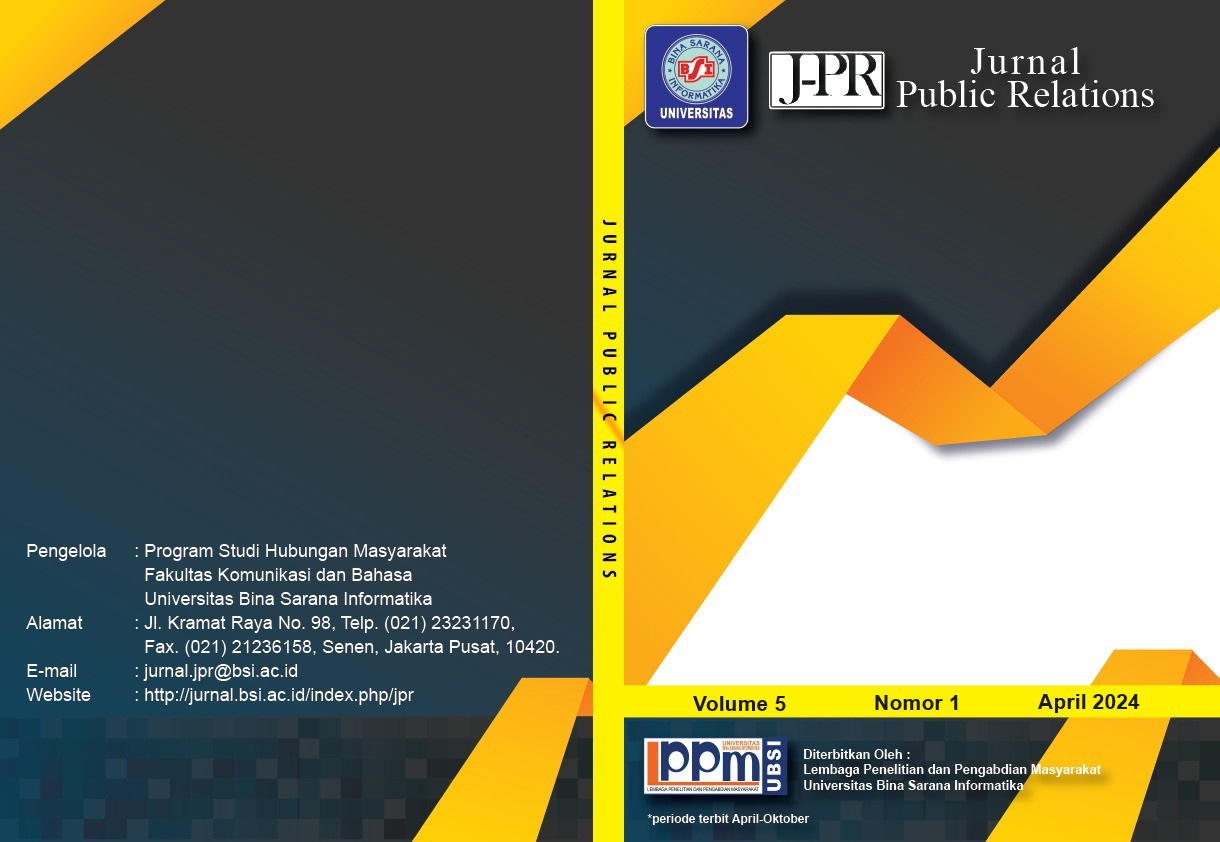Public Relations Vindes Media Corp di Era Post-Truth: Evolusi Psikologis Persepsi Masyarakat Urban
DOI:
https://doi.org/10.31294/jpr.v5i1.3311Keywords:
Public Relations, Era Post-Truth, Psikologi Komunikasi, Masyarakat Urban, Media DigitalAbstract
Aktivitas Public Relations (PR) yang diterapkan oleh Vindes Media Corp, sebuah platform media digital yang ditujukan untuk generasi muda, dalam era post-truth. Di tengah maraknya disinformasi dan skeptisisme terhadap kebenaran, penting bagi perusahaan media digital seperti Vindes untuk membangun komunikasi yang efektif dan kredibel dengan audiensnya, terutama masyarakat urban yang merupakan target utama mereka. Melalui analisis kualitatif berdasarkan teori psikologi komunikasi dan studi kasus terhadap kampanye PR Vindes, penelitian ini mengungkap bagaimana strategi PR Vindes beradaptasi dengan tantangan era post-truth untuk mempertahankan kepercayaan dan meningkatkan engagement dengan generasi muda urban. Temuan utama menunjukkan bahwa transparansi, autentisitas, dan penggunaan narasi yang resonansi secara emosional menjadi kunci dalam membangun persepsi positif. Lebih lanjut, penelitian ini mengidentifikasi bahwa pemanfaatan influencer dan kampanye sosial yang berorientasi pada nilai-nilai komunitas efektif dalam mengatasi skeptisisme dan memperkuat posisi Vindes sebagai media yang empower dan relevan bagi audiensnya.
References
Bazeley, P., & Jackson, K. (2013). Qualitative Data Analysis with NVivo. SAGE Publications.
Bennett, W. L., & Segerberg, A. (2012). The logic of connective action. Cambridge University Press.
Bowen, G. A. (2009). Document Analysis as a Qualitative Research Method. Qualitative Research Journal, 9(2), 27-40.
Braun, V., & Clarke, V. (2006). Using thematic analysis in psychology. Qualitative Research in Psychology, 3(2), 77-101.
Bounegru, L., Gray, J., Venturini, T., & Mauri, M. (2018). A Field Guide to "Fake News" and Other Information Disorders. Public Data Lab.
Castells, M. (2007). Communication, Power and Counter-power in the Network Society. International Journal of Communication, 1.
Chouliaraki, L. (2013). The Ironic Spectator: Solidarity in the Age of Post-Humanitarianism. Polity.
Couldry, N. (2012). Media, Society, World: Social Theory and Digital Media Practice. Polity Press.
Creswell, J. W., & Poth, C. N. (2018). Qualitative Inquiry and Research Design: Choosing Among Five Approaches. SAGE Publications.
Edelman. (2020). 2020 Edelman Trust Barometer. Edelman.
Fisher, M. (2019). Urban Audiences: Dissecting the Critical Consumer in the City. Urban Studies, 56(13), 2737-2753.
Grunig, J. E., & Hunt, T. (1984). Managing Public Relations. Holt, Rinehart, and Winston.
Heath, R. L., & Waymer, D. (2017). Public Relations and Communication Management: Current Trends and Emerging Topics. Routledge.
Holtzhausen, D. (2020). Strategic Communication in a Global Crisis. Routledge.
Jenkins, H. (2009). Confronting the Challenges of Participatory Culture: Media Education for the 21st Century. MIT Press.
Jenkins, H., Ford, S., & Green, J. (2013). Spreadable Media: Creating Value and Meaning in a Networked Culture. NYU Press.
Kaplan, A. M., & Haenlein, M. (2010). Users of the world, unite! The challenges and opportunities of Social Media. Business Horizons, 53(1), 59-68.
Kietzmann, J. H., Hermkens, K., McCarthy, I. P., & Silvestre, B. S. (2011). Social media? Get serious! Understanding the functional building blocks of social media. Business Horizons, 54(3), 241-251.
L'Etang, J. (2018). Public Relations: Concepts, Practice and Critique. SAGE Publications.
Lewandowsky, S., Ecker, U. K. H., & Cook, J. (2017). Beyond Misinformation: Understanding and Coping with the "Post-Truth" Era. Journal of Applied Research in Memory and Cognition, 6(4), 353-369.
Loader, B. D., & Mercea, D. (2011). Networking Democracy? Social Media Innovations and Participatory Politics. Information, Communication & Society, 14(6), 757-769.
Marwick, A. (2015). Instafame: Luxury Selfies in the Attention Economy. Public Culture, 27(1 75), 137-160.
McLeod, S. (2018). Uses and Gratifications Theory. Simply Psychology.
McQuail, D. (2010). McQuail's Mass Communication Theory. SAGE Publications.
Molleda, J. C. (2010). Globalization and Public Relations: Challenges and Opportunities. Journal of Public Relations Research, 22(4), 361-373.
QSR International. (2020). NVivo Qualitative Data Analysis Software.
RAZALI, Geofakta; HIDAYAT, Rizki. Strategy and Function of Perfect Health's Public Relations Activities in Enhancing a Positive Image through Philanthropic Corporate Social Responsibility. Jurnal Komunikasi Ikatan Sarjana Komunikasi Indonesia, [S.l.], v. 7, n. 1, p. 56-62, june 2022. ISSN 2503-0795. Available at: <http://jurnal-iski.or.id/index.php/jkiski/article/view/616>. Date accessed: 13 mar. 2024. doi:https://doi.org/10.25008/jkiski.v7i1.616.
Smith, B. G. (2018). Social Media Participation in an Activist Movement for Racial Equality. Journal of Social Media in Society, 7(1).
Vindes Media Corp. (2022). Empowering the Youth through Digital Media: A Vindes Strategy Report. Vindes Media Corp.
Wardle, C., & Derakhshan, H. (2017). Information Disorder: Toward an interdisciplinary framework for research and policy making. Council of Europe report.
Yin, R. K. (2018). Case Study Research and Applications: Design and Methods. SAGE Publications.
Zhao, Y., & Witschge, T. (2021). Navigating the Post-Truth Debate: Current Perspectives and Future Directions. Media and Communication, 9(1), 207-217.
Downloads
Published
How to Cite
Issue
Section
License
Copyright (c) 2024 Geofakta Razali, Reni Dyanasari

This work is licensed under a Creative Commons Attribution-ShareAlike 4.0 International License.













